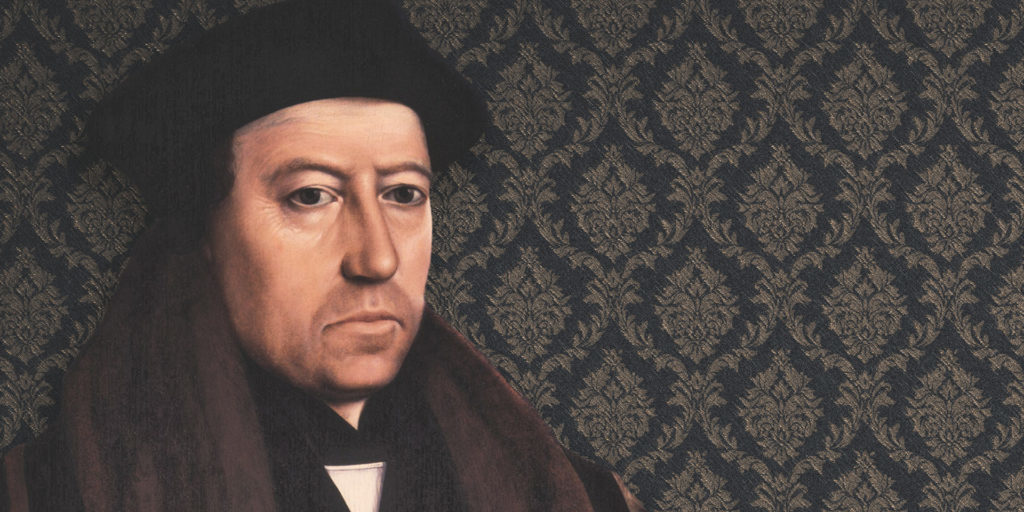
Why Pastors Should Engage Thomas Cranmer
Thomas Cranmer is often referred to as the architect of the English Reformation. He served in the top job in the English church as Archbishop of Canterbury. He helped with the original “Brexit” as he assisted King Henry VIII break from the Roman Church in his long quest for a male heir. This break gave birth structurally to the Church of England (Anglican/Episcopalian Church). Theologically, Cranmer swiftly pressed forward with the Reformation under Protestant King Edward VI. Under Catholic Queen Mary I, Cranmer would be amongst the martyrs of “Bloody Mary” who “baptized the English Reformation in blood.”[i]
Unfortunately, Cranmer is sometimes forgotten amongst the reformers of the sixteenth century. Luther and Calvin are usually familiar household names, Bucer and Melanchthon possibly known by seminary students, but Cranmer often falls by the wayside. He has so much to offer the Church today and is therefore worth getting to know. So, why should we engage Thomas Cranmer? Because he helps us thoughtfully engage with the tension between the unchanging authority of Scripture, and the changing forms of our church services.
The unchanging authority of Scripture: Cranmer treasured the Bible
Cranmer held to sola Scriptura, the first, or formal principle of the Reformation from which all other Protestant doctrines flow. He believed deeply in Scripture’s sufficiency, clarity, necessity, authority, and intelligibility, and therefore wanted the Bible translated into English to be read by the people. Cranmer worked hard to get an authorized English Bible into the hands of the English people, and joined in with the efforts of other English reformers like Thomas Cromwell, Miles Coverdale, John Rodgers, and William Tyndale.[ii] Tyndale’s last words at the stake were, “Lord, open the King of England’s eyes.” Two years later, in 1539, King Henry VIII placed a copy of the first authorized English translation, The Great Bible, in every church in England. He believed deeply in Scripture’s sufficiency, clarity, necessity, authority, and intelligibility, and therefore wanted the Bible translated into English to be read by the people. Click To Tweet
Cranmer wanted all English people to be able to access the Bible in their mother tongue. It was an evangelistic strategy for him, as many missionaries over the years can also testify. The cover page to The Great Bible depicted Henry VIII seated on his throne at the center, handing Bibles to Cranmer and Cromwell, who in turn are handing Bibles to the church and State leaders, who are handing them and reading them to the people. The Great Bible was to be read out in every church, and Cranmer had an important hand in legislating this. On the cover page, those listening to the Word of God being read included the types of people Cranmer wanted to read the Bible: the rich and poor; soldiers and craftsmen; a mother with her children; children with their mother. Even someone in jail is depicted. Cranmer wanted everyone to read the Bible. This is what he laboured for, and what, under God and with the help of others, he achieved.
Cranmer wrote a “how to read the Bible” guide for the second edition of The Great Bible. Entitled Preface to the Bible (1540) it drew on the theology of John Chrysostom (d.407) and Gregory of Nazianzus (d.390) regarding how the Bible should be read. Cranmer, as well as the other reformers, were at pains to show that the way they were reading the Bible was not new! In a world where we are often searching for the newest thing, Cranmer is helpful reminder that in the Christian faith, new does not equal better, and in fact rarely does. Forms may change, but content doesn’t. Cranmer was anything but innovative theologically, as his Preface to the Bible and other writings demonstrate.
This Preface to the Bible became a classic statement of sola Scriptura and is well worth every pastor reading. In it he wrote:
“Here may all manner of persons, men, women, young, old, learned, unlearned, rich, poor, priests, laymen, lords, ladies…virgins, wives, widows, lawyers, merchants…and all manner of persons…may in this book learn all things what they ought to believe, what they ought to do, as what they should not do … It is convenient and good the Scripture be read of all sorts and kinds of people, and in the vulgar [common] tongue.”[iii]
All these efforts to produce the Bible in English should make us very thankful to God each time we open ours for the great efforts by Cranmer and others who helped make this happen. So much blood was spilled to make reading our Bibles a reality. Cranmer eventually went to the stake for adhering to its contents; and his efforts to get the Bible into as many English hands as possible were fraught with difficulty as he pushed for reform when it was at times dangerous to do so.
The changing form of church services: Cranmer was communication-savvy
Having got an official translation of the English Bible in place and accessible to the people of England, Cranmer was then able to address changes in the church service to make it more biblically reformed. While Cranmer’s way of reading the Bible was not new, and aligned with the early church and Church Fathers, he needed to make the form of church services new. Towards the end of his reign, Henry VIII went back on some of the theological progress of the Reformation and things became very difficult for Protestants, so Cranmer had to wait until King Edward VI came to the throne.
A young boy of 9, King Edward was nevertheless deeply Protestant in his convictions, as were his advisors. Under Edward, Cranmer’s efforts gained traction, and he implemented the English Reformation theologically and practically. Cranmer was a communications genius, and it is his liturgy for which he is often best known. This liturgy was contained in the first official Prayer Book (1549), followed by his revised edition (1552), which were in English rather than Latin, so the services could be understood by the English people. In the Prayer Book, Cranmer laid out how a church service was to be conducted in the Church of England. He modelled it on the Roman Missal, largely because he was well aware of the dangers of changing the form of the service too quickly for the people. He worked within an existing structure but changed the content – often a hallmark of good communication.
In the Prayer Book, Cranmer was very deliberate in the way he structured the church service – there is theological progression running throughout the entirety. Cranmer also recognised the teaching element of everything that was seen and heard. What the minister said, how the congregation responded, how the minister moved, gestured with his hands, where he stood, how the congregation moved and so on; all of this was deliberately laid out to make sure that the reformed faith was on show, communicated and understood at every point by the people. Cranmer’s church service was also remarkably participatory. He wanted active rather than passive attenders at church, in contrast to the medieval Catholic Church where the priest performed the sacraments while the attenders remained passive.
If you have not read the Prayer Book before, even as a modernized version, it is well worth having a look at. As we carefully consider how we put together our church services, Cranmer helps us reflect on how deliberately we need to consider each element of our time gathered together. Even if we do not have formal liturgy in our services, we tend to develop an informal liturgy by our practices and words that are repeated week by week, and these are imbibed as theological truths by the congregation. Cranmer can help us on our way to carefully considering each aspect of our service and what it communicates of the gospel. He can help us as we seek to hold on to the unchanging Christian faith, and appropriately update the form of our services to communicate these gospel truths effectively.
Benefit of Cranmer
So, why should pastors engage with Thomas Cranmer? Because he helps pastors as they uphold the tension between the unchanging Scriptures and the changing church forms and services. First, he encourages pastors to teach the unchanging Scriptures to everybody. Cranmer’s labours to get the English Bible into every church and understood by every person in England is an outworking of his conviction on the doctrine of sola Scriptura. Second, his Preface to the Bible (1540) provides pastors with theological categories for reading the Bible which build on the work of Chrysostom, Gregory of Nazianzus and others, encouraging them that the apostolic faith passed down is not new, but unchanging. Third, Cranmer helps pastors thoughtfully craft church services which communicate the gospel clearly. His Prayer Book demonstrates his careful regard of communicating through existing forms, the intentional nature of the pastor’s verbal and non-verbal communication of the gospel, the necessity that all parts of the service are understood by the congregation, and the importance of participation of the congregation in the service. In doing this, Cranmer provides pastors with help in the way they shape their church services to make the gospel of Jesus Christ clear to everyone.
Endnotes
[i] Owen Chadwick, The Reformation (Harmondsworth: Penguin, 1968), 128.
[ii] Thomas Cromwell instigated the project; Miles Coverdale started translation work on it; John Rodgers, Mary’s first martyr, contributed hugely to the translation work and William Tyndale paved the way with his own translation work, but was strangled and burned for his efforts.
[iii] Thomas Cranmer, Preface to the Bible 8;9 , cited in Gerald Lewis Bray, Documents of the English Reformation : 1526-1701 (Cambridge, Eng.: James Clarke & Co, 1994), 239.

